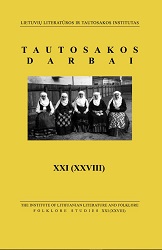ETNINĖS KULTŪROS ELEMENTAI JAUNIMO ORGANIZACIJŲ VEIKLOJE
TRACES OF ETHNIC CULTURE IN THE ACTIVITIES OF YOUTH ORGANIZATIONS
Author(s): Laimutė AnglickieneSubject(s): Cultural history, Customs / Folklore, Music, Cultural Anthropology / Ethnology
Published by: Lietuvių literatūros ir tautosakos institutas
Keywords: Ethnic culture; youth organizations; folksongs; Lithuania; ethnic heritage;
Summary/Abstract: The article discusses folklore performed by Lithuanian youth organizations (scouts, members of Ateitis Foundation, and hikers). The author focuses on the spread of Lithuanian folksongs in their repertoire, also taking into account the general usage of the whole Lithuanian ethnic heritage in their contemporary activities. Directions taken up by various groups in any organization largely depend upon the goals promoted by its leaders and upon the needs of the group members. Therefore among these youth organizations, certain groups characterized by a marked ethnic orientation could be spotted, e.g. the St. Kazimieras group of Ateitis Foundation in Kaunas, lead by V. Zulonaitė. The most distinct traces of ethnic culture are to be found in calendar festivals, celebrated by many groups. Occasionally, in order to get better skilled in folk customs, folksongs, games and dances, the groups would invite folklore ensembles to join them during these festivals. The folksongs do not comprise the major part of the total singing repertoire of the organizations in question. Moreover, their performance may be regarded as that of the second or third order, because they adapt these songs from the folklore ensembles, which had in turn sifted them through. Still, the most popular Lithuanian folksongs tend to be recently replaced by some more rare and regional ones. The song repertoire is defined by the age of the kids. Junior pupils particularly favor the folksongs, while teenagers prefer pieces by popular music groups. According to the genre, the most popular are children songs (most frequently the rhymes), the youth and love songs, and humorous songs. As observed by the members of the organizations, the choice of the song depends on its inner energy, liveliness, and clear rhythm. Along with songs, other kinds of folklore are also used in the organized activities, although less frequently. Folk games and rounds are played and folk dances performed during various festive occasions. The short forms of folklore could be enriched by scout slogans, serving to perform an entertaining function.
Journal: Tautosakos darbai
- Issue Year: 2006
- Issue No: 32
- Page Range: 189-202
- Page Count: 14
- Language: Lithuanian

